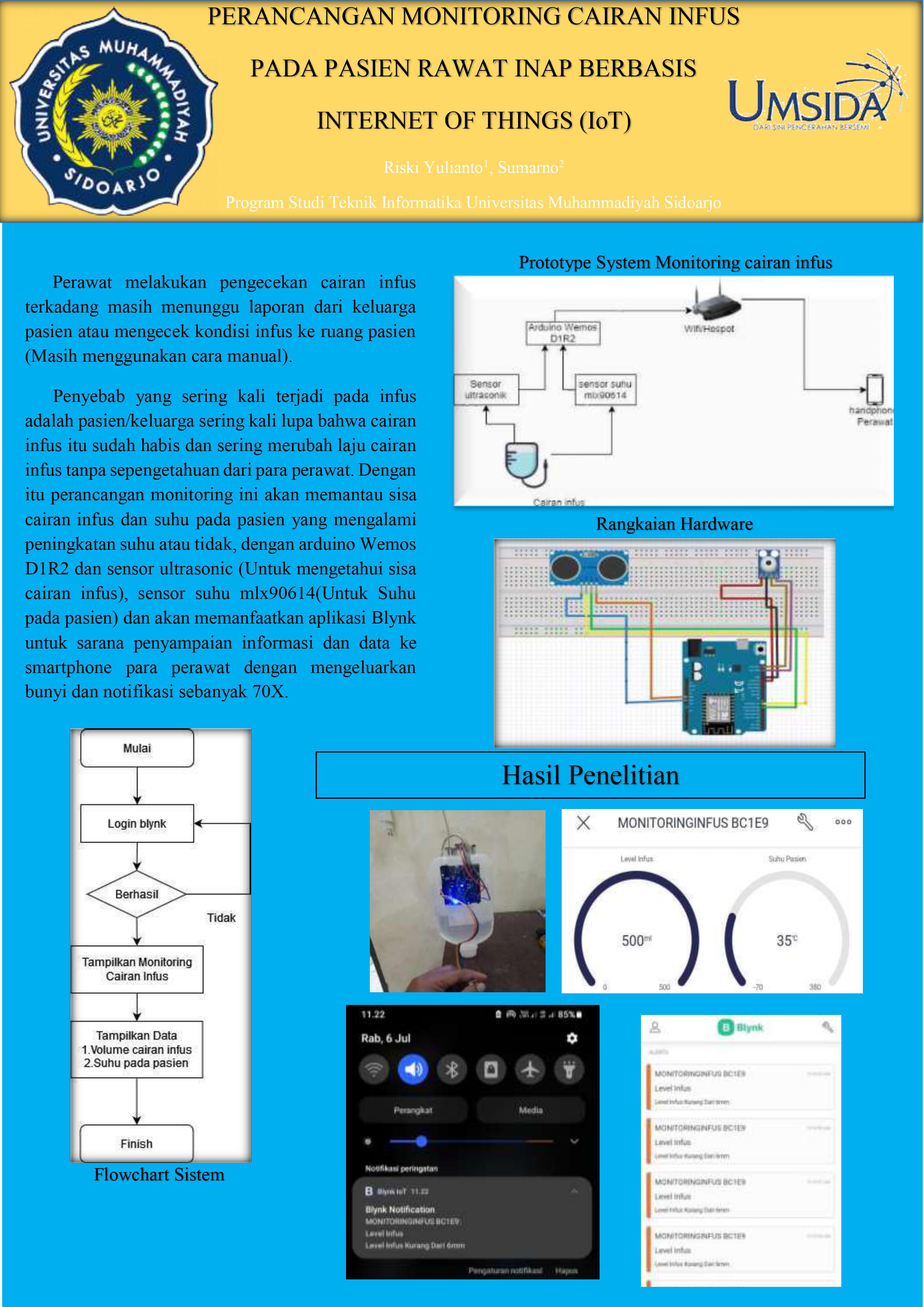Design of Intravenous Fluid Monitoring in Inpatients Based on Internet of Things (IoT)
Perancangan Monitoring Cairan Infus Pada Pasien Rawat Inap Berbasis Internet of Things (IoT)
DOI:
https://doi.org/10.21070/pels.v2i2.1221Keywords:
Arduino, Blynk, Infusions, Medical Devices, UltrasonicAbstract
Infusion is a medical device that is used to replace lost body fluids or nutrients in some emergency or urgent situations, such as in patients who are dehydrated, unable to digest food by mouth, replaced by intravenous fluids, as for some disorders that usually occur such as blockage of fluids that cause effects. The type of research used is quantitative research with experimental methods. Methods of data collection using the method of observation, interviews, and literature study. The data source of this research uses the Research Library. The data processing methods of this research are reduction and coding. The analysis used is quantitative data analysis. The system built can make it easier for medical users to control infusion fluids in real time (24 hours). The results of this study are sending data every 10-12 seconds, and auto refresh on the blynk application every 5 seconds with a measurement error percentage of 2.25 from the results of manual measurements and sending notifications to smartphones if the volume of infusion fluid is below 6 MM as much as 70x. So that in this prototype the data sharing process was successfully carried out because the ultrasonic data and the temperature of Mlx90614 for infusion fluids were successfully stored in the Blynk database via Arduino Wemos D1R2.
Downloads
References
A. Nadia, R. Rasyid, dan Harmadi, “Sistem Monitoring Ketinggian Cairan Infus Berbasis Sensor Serat Optik Evanescent,” J. Fis. Unand, vol. 8, no. 4, hal. 321–328, 2019, [Daring]. Tersedia pada: http://jfu.fmipa.unand.ac.id/index.php/jfu/article/view/432.
R. Agussalim, A. Adnan, dan M. Niswar, “Monitoring Cairan Infus Berdasarkan Indikator Kondisi Dan Laju Cairan Infus Menggunakan Jaringan Wifi,” Ilk. J. Ilm., vol. 8, no. 3, hal. 145–152, 2016, doi: 10.33096/ilkom.v8i3.69.145-152.
I. Gunawan, A. Sudianto, dan M. Sadali, “Measuring Body Temperature Based Internet of Things (IoT) Using Esp8266 and Firebase,” Sisfotenika, vol. 11, no. 1, hal. 91, 2021, doi: 10.30700/jst.v11i1.1060.
K. R. Rao dan K. E. Supriya, “Design and development of iot based intravenous infusion system,” Lect. Notes Electr. Eng., vol. 569, no. December 2019, hal. 487–499, 2020, doi: 10.1007/978-981-13-8942-9_40.
Halifatullah, Ismail, “Rancang Bangun Sistem Monitoring dan Kontrol Infus Dengan Penerpan Internet of Things (IoT) Berbasis Android,” POSITIF Jurnal Sistem dan Teknologi Informasi 5(2):81, 10.31961/positif.v5i2.740
R. Maharani, A. Muid, dan U. Ristian, “Sistem Monitoring Dan Peringatan Pada Volume Cairan Intravena ( Infus ) Pasien Menggunakan Arduino Berbasis Website,” Komput. dan Apl., vol. 07, no. 03, hal. 97–108, 2019.
M. A. Islam, S. Kundu, S. S. Alam, T. Hossan, M. A. Kamal, dan R. Hassan, “Prevalence and characteristics of fever in adult and paediatric patients with coronavirus disease 2019 (COVID-19): A systematic review and meta-analysis of 17515 patients,” PLoS One, vol. 16, no. 4 April, hal. 1–21, 2021, doi: 10.1371/journal.pone.0249788.
Heady Dianty, “MENDETEKSI SUHU TUBUH MENGGUNAKAN INFRARED DAN ARDUINO,” Jurnal Ilmu Komputer, 3(3), 4. [Daring]. Tersedia pada: https://www.jurnal.pranataindonesia.ac.id/index. php/jik/article/view/23
K. Hidayati dan R. B. Barwaqah, “Monitoring Cairan Infus Secara Realtime,” JISA (Jurnal Inform. dan Sains), vol. 1, no. 2, hal. 62–66, 2018, doi: 10.31326/jisa.v1i2.344.
H. Xu et al., “Possible environmental effects on the spread of COVID-19 in China,” Sci. Total Environ., vol. 731, hal. 139211, 2020, doi: 10.1016/j.scitotenv.2020.139211.




